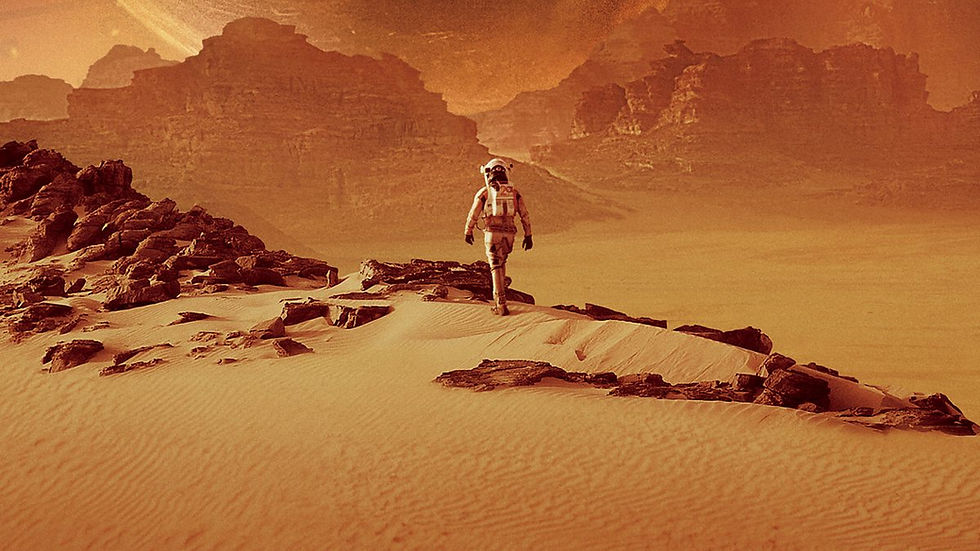
Jonathan Svilik
Aug 30, 2024
THE STORY
This episode of AstroArticulated will explore the scientific accuracies, inaccuracies, and implications of Andy Weir’s The Martian. The legendary science fiction novel and 2015 movie adaptation starring Matt Damon is set in the year 2035, and follows the journey of the astronauts aboard the Ares 3 mission to Mars. A few days after landing in the alien Martian desert, the team encounters a storm with unprecedented winds, forcing mission commander Melissa Lewis to give the order to abort the mission. As the astronauts make their way through treacherous winds to the “MAV” (Mars Ascent Vehicle), botanist and engineer Mark Watney, is impaled by an antenna. Nearly dead, Mark finds himself stranded and alone on Mars. As he stitches his wounds and settles into the “Hab” (the crew’s livable Martian habitat), he makes the decision that he will not die on Mars. He will survive.
From that point on, Mark Watney does everything he can to survive until the Ares 3 crew returns to Mars to rescue him. Using his botany background, Mark transforms the Hab into a potato farm and even uses his own waste as manure. In order to create water to feed the seedlings, he utilizes an iridium catalyst to separate hydrogen gas from leftover hydrazine: rocket fuel. This solves his nutritional problem. However, from an engineering standpoint, Mark has a major problem that will determine his chances of survival: communication. During the storm, the antenna that impales Mark also knocks out communication between the Hab and NASA. Eventually, NASA realizes that Mark has survived the storm and begins their plan to rescue the lone astronaut. During this time, Watney uses a leftover Mars rover to travel to the site of the Pathfinder lander and the Sojourner rover, the remnants of a project that had been shutdown. Back on Earth, NASA understands that Mark has gone after the Pathfinder, as it will allow him to communicate with them. Immediately, the members of the retired project are notified and they begin to develop a method of communication with Mark, using the hexadecimal system.
All appears to be going well, and Watney’s probability of survival has greatly increased - that is until the airlock that Mark frequently uses to enter the Hab malfunctions and rips. This results in the depressurization of the Hab and the death of all the potato crops. Now in an even more dire situation, NASA sends an ill inspected supply probe to Mars. Unfortunately, this probe explodes on liftoff, leaving NASA and Mark in a very difficult situation. At this point, Mark’s journey is being followed globally, and the China National Space Agency decides to lend the Americans an advanced rocket booster to aid in their mission. The new plan is to send the probe with the booster to Mars, with the necessary supplies that will allow Mark Watney’s survival until the Ares 4 arrives.
However, Richard Purnell, an astrodynamicist, has other plans. He has devised a “slingshot” trajectory for the Ares 3 crew aboard the Hermes, that will allow them to return to Mars in time to save Watney. As they pass Earth, the supply probe, powered by the Chinese booster, will be intercepted by the Hermes. This ron de vu will provide necessary food and supplies for the crew and eventually for Mark, when he joins them.
MARS BACKGROUND
Mars is approximately 140 million miles away from the Earth, though this distance can vary throughout their respective orbits about the Sun. As discussed throughout the novel, the Martian climate is extremely cold, but can be variable depending on your distance from the surface. For example, when standing on the surface of Mars, the difference in temperature of the air around your head and around your feet can differ by more than 24 degrees celsius. Due largely to the planet's thin atmosphere which allows heat to easily escape, the surface temperature can be as high as 20 degrees celsius or as low as -153 degrees celsius. The “Red Planet’s” cold temperatures have resulted in the deep freeze of its vast water supply. Scientists theorize that 3 billion to 4.1 billion years ago, Mars was much warmer and was covered in lakes, rivers, and oceans: ideal conditions for life.
Although Mars is notably cold, there is evidence that the planet is still volcanically active; recently a mantle plume (a large amount of hot material pushing on the crust from the planet’s mantle) was discovered in a sizable region. This phenomenon is similar to mantle plumes often seen on Earth. Another notable characteristic of the Martian environment is diminished gravity (roughly 38%) when compared to Earth, a by-product of the planet’s smaller mass. Mars also has two moons in contrast to our one, both tidally locked. In addition, the Martian day, also referred to as a “sol,” is about 40 minutes longer than an Earth day, with the Martian year occupying 668.6 sols(1.88 Earth years).
THE PHYSICS OF THE MARTIAN
This idea of a slingshot orbit, the relative orbits of Earth and Mars, and an in-depth look at the physics within The Martian, will be further discussed with Dr. Alinda Mashiku. Below is a short introduction to Dr. Mashiku, her specific relationship, and unique knowledge pertaining to the physics-packed world of The Martian.
Dr. Mashiku earned her bachelor’s degree in Aerospace and Astronautical Engineering from The Ohio State University. She then went on to study Aerospace and Astronautical Engineering at Purdue University, earning her masters and PhD. In the years that followed, Dr. Mashiku co-founded The Joule Foundation, a non-profit organization committed to encouraging girls in Africa to pursue STEM focused careers. Since 2013, Dr. Mashiku has worked at the NASA Goddard Space Flight Center in orbital dynamics as a space flight trajectory engineer. She is currently the manager of NASA’s Conjunction Assessment Risk Analysis program.